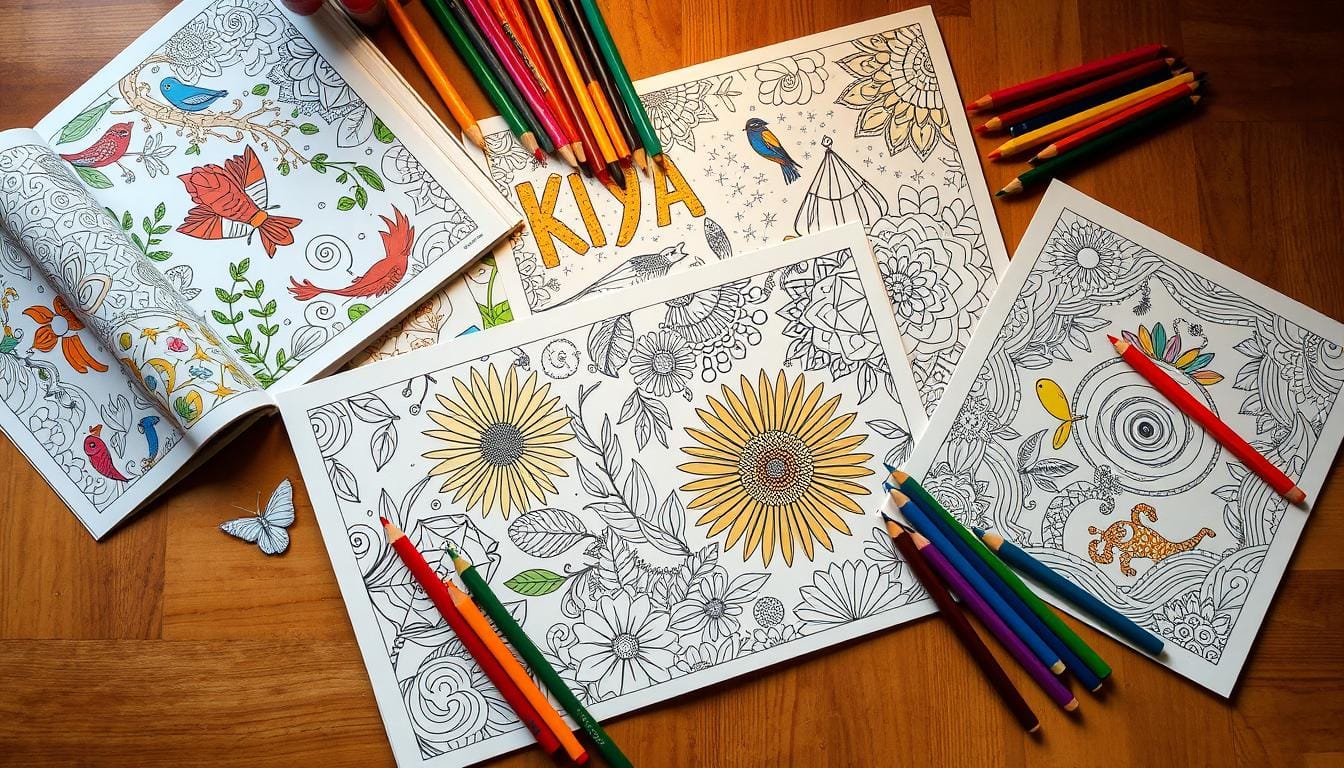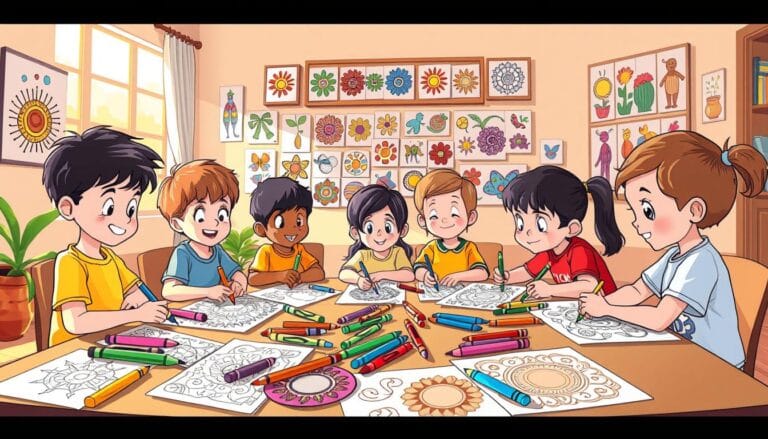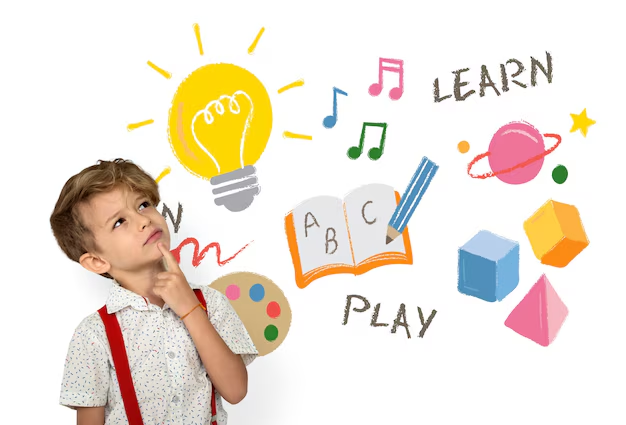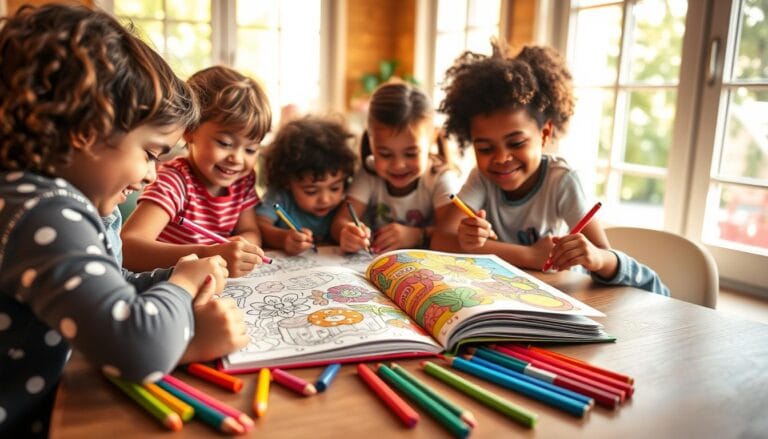Why Coloring Books Matter in Child Development
Have you ever thought about how coloring books for kids affect their growth? As kids move from simple drawings to more detailed coloring activities, they hit big milestones.
Rachel Annunziato, Ph.D., from Fordham University, says that improving coloring skills shows kids are getting better at using their bodies and thinking.
Looking into coloring books shows how much they help kids grow. They improve fine motor skills and boost creativity.
Key Takeaways
- Coloring books are key to a child’s brain growth.
- Getting better at coloring is a big step for kids.
- Coloring helps kids with their fine motor skills and creativity.
- Coloring books are a fun way to help kids develop.
- Coloring books are essential for kids’ growth.
The Overlooked Power of Coloring Books
Coloring books are more than just fun for kids. They help in their development. As a parent or caregiver, knowing this can guide your choices for your child’s activities.
Beyond Just Fun: The Developmental Significance
Coloring books are not just for fun. They help improve fine motor skills, cognitive abilities, and creativity. They help kids get better at hand-eye coordination and dexterity. This is important for their future school success.
Coloring books are important in many ways. They help kids:
- Get better at fine motor skills by coloring
- Improve their thinking and spatial awareness
- Be more creative with colors and imagination
What Research Reveals About This Simple Activity
Research shows that coloring books are very beneficial for kids. They help kids focus, recognize patterns, and make decisions. Coloring also lets kids express themselves and deal with their feelings.
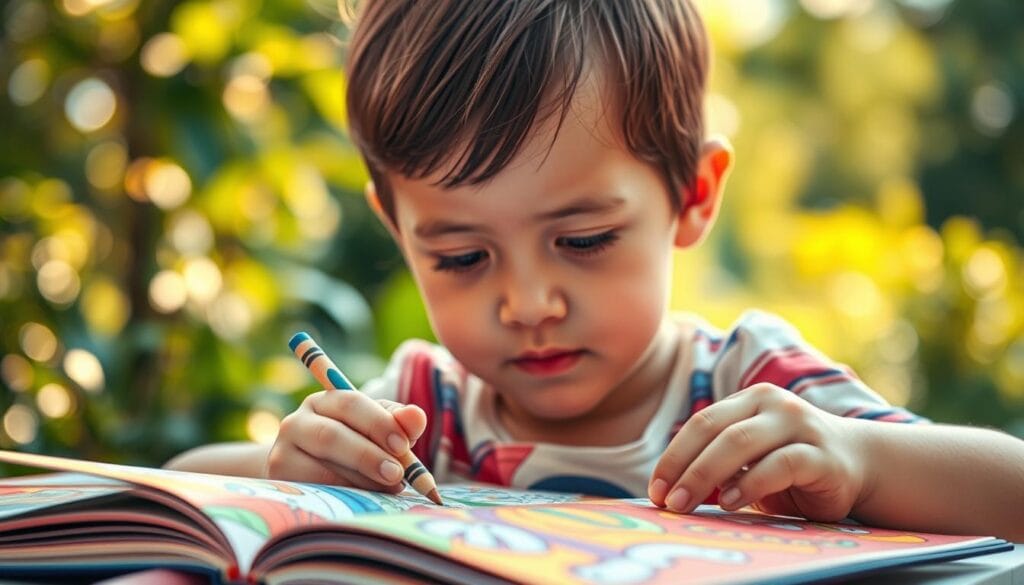
Experts agree that coloring books are very beneficial. They help kids grow and develop. By making coloring a part of their daily routine, parents and caregivers can help their kids a lot.
Why Coloring Books Matter in Child Development: An Overview
Coloring books play a big role in child development. They have a long history and are backed by modern research. You might wonder how coloring can impact a child’s growth so much.
For many years, coloring books have been a part of children’s lives. They are not just for fun but also for learning and growing. Coloring helps with important skills like thinking and moving.
Historical Perspective on Coloring Books
Coloring books have been around for over a century. They were first used to teach children about different subjects through pictures. They helped kids improve their fine motor skills and creativity.
| Era | Use of Coloring Books | Educational Significance |
|---|---|---|
| Early 20th Century | Introduction as educational tools | Development of fine motor skills and creativity |
| Mid 20th Century | Expansion into various subjects | Learning about history, science, and literature through images |
| Late 20th Century to Present | Digital coloring and diverse themes | Enhanced cognitive skills and adaptability |
Modern Research on Coloring Activities
Today, research shows that coloring is key for kids. It helps them focus, think creatively, and solve problems. It also helps them express themselves.
Learning through coloring is now a big topic in education. Educational coloring books teach kids about many subjects. They make learning fun and exciting.
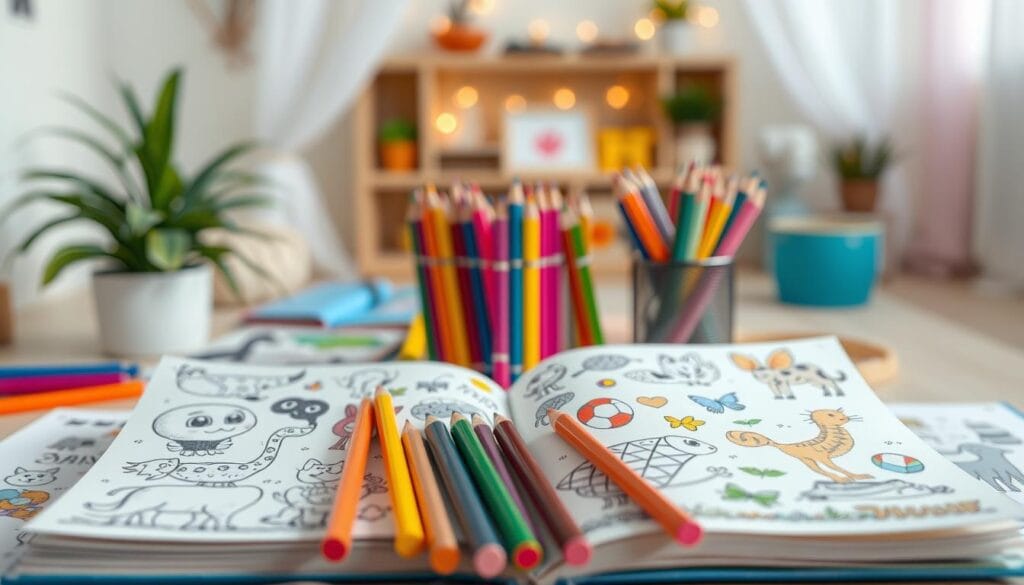
Adding coloring to your child’s daily routine is great for their learning. As research keeps showing, coloring is more than a hobby. It’s a vital part of a child’s education.
Fine Motor Skills Development Through Coloring
Coloring books are more than just for fun. They help develop fine motor skills needed for handwriting and precise movements. As kids color, they get better at handling objects, a key skill for growth.
Pencil Grip and Hand Strength
Coloring helps kids learn to hold pencils right and build hand strength. This is important for writing and other precise tasks.
Precision and Control Development
Coloring boosts kids’ precision and control over their hands. This skill is key for detailed work like writing and drawing.
Hand-Eye Coordination Enhancement
Coloring also improves hand-eye coordination. Kids learn to match their hand movements with what they see. This is vital for many physical and academic tasks.
Preparation for Handwriting
The fine motor skills from coloring are great for handwriting. Kids who color often find writing easier because they’ve already developed the needed hand strength and coordination.
| Fine Motor Skill | Description | Benefit |
|---|---|---|
| Pencil Grip | The ability to hold a pencil correctly | Essential for writing |
| Hand Strength | Muscle development in the hands | Crucial for precise movements |
| Hand-Eye Coordination | Coordination between hand movements and vision | Important for dexterity and overall physical coordination |
Cognitive Benefits of Regular Coloring Activities
Coloring offers many cognitive benefits for kids. It helps improve their development in many ways. Regular coloring can greatly enhance a child’s cognitive abilities.
Focus and Concentration Improvement
Coloring helps kids focus and concentrate better. It teaches them to stay on task. This skill is key for doing well in school.
Pattern Recognition and Spatial Awareness
Coloring, especially with complex patterns, boosts pattern recognition and spatial awareness. These skills are vital for solving problems and doing math.
Decision-Making Skills
Coloring requires kids to make choices, like picking colors and staying within lines. These decisions sharpen their critical thinking.
Color Selection and Planning
Choosing colors and planning their artwork encourages creativity and informed decision-making.
Problem-Solving Through Coloring
Coloring presents challenges, like staying within lines or mixing colors. Overcoming these helps kids develop problem-solving skills.
Regular coloring boosts cognitive skills like focus, pattern recognition, and decision-making. It also nurtures creativity and imagination. These benefits can greatly impact their academic and personal growth.
Emotional and Psychological Benefits
Coloring can greatly improve a child’s emotional and psychological health. It offers many benefits that can make a child feel better overall.
Stress Reduction and Relaxation
Coloring is a calming activity that can reduce stress and anxiety in kids. It helps them relax, much like meditation. This is great in today’s busy world where kids face many stressors.
Key benefits of stress reduction through coloring include:
- Lower anxiety levels
- Improved mood
- Better sleep quality
Self-Expression and Emotional Processing
Coloring lets kids express themselves and process their emotions. They can show their feelings through colors and how they color, without words.
Building Confidence Through Completion
Finishing a coloring page makes kids feel proud and accomplished. It’s especially helpful for kids who lack confidence, showing them what they can do.
Processing Difficult Emotions
Coloring is a healthy way for kids to deal with tough emotions. It helps them understand and manage their feelings better.
Creativity and Imagination Development
Coloring books are more than just fun. They help your child grow their creativity and imagination. By coloring, your child gets to try out different colors and patterns. This boosts their creative thinking.
Color Selection and Creative Thinking
Choosing colors for a coloring page is key to creativity. Your child learns to pick colors, shades, and textures. This builds their confidence in making something unique.
Storytelling Through Coloring
Coloring can be a way to tell stories. As your child colors, they might create stories about the pictures. This improves their imagination and lets them share ideas through pictures. It’s a great way to support their creativity and learning.
Social Skills Enhancement Through Group Coloring
Group coloring is a fun way to teach kids important social skills. It helps them learn about working together and respecting each other.
When kids color together, they start to see the value of sharing and collaboration. They learn to take turns, share crayons, and make a picture together.
Sharing and Collaboration
Sharing and working together are key skills kids get from group coloring. They learn to compromise and value each other’s ideas.
| Benefits of Group Coloring | Description |
|---|---|
| Sharing | Children learn to share materials and ideas. |
| Collaboration | Children work together to achieve a common goal. |
Communication Development
Group coloring also helps with communication development. Kids learn to share their thoughts, listen, and solve disagreements.
As they keep coloring together, they get better at talking and listening. This skill helps them in many areas of life.
Educational Benefits of Themed Coloring Books
Themed coloring books make learning fun for kids. They turn complex subjects into exciting activities. These books offer a full learning experience.
Subject-Specific Learning
These books focus on specific subjects, making learning fun. Science and nature coloring books introduce kids to the natural world.
Science and Nature Coloring Books
Science and nature books teach kids about species and ecosystems. They spark an early love for science and nature.
History and Culture Through Coloring
History and culture coloring books take kids on journeys through time. They learn about important events and cultural practices. This way, history becomes more fun and accessible.
Language and Vocabulary Expansion
Themed coloring books also help with language skills. As kids color, they learn new words. Educational coloring books often include captions to help with vocabulary.
Using themed coloring books, kids can grow their vocabulary. This tool is great for parents and teachers to help kids learn through coloring.
Therapeutic Applications of Coloring for Children
Coloring is a special way for kids to express themselves and relax. It helps them feel better overall. It’s good for their feelings and mind.
Coloring for Children with Special Needs
Coloring is great for kids with special needs. It calms and organizes them. For these kids, coloring is more than fun; it’s a way to feel better.
Autism Spectrum and Sensory Processing
For kids with autism, coloring is a calming activity. It’s predictable and meets their sensory needs.
ADHD and Focus Enhancement
Coloring helps kids with ADHD focus better. It’s a structured activity that reduces hyperactivity.
Coloring as a Calming Technique
Coloring is a great way to calm kids down. It reduces stress and anxiety. By coloring, kids can relax.
| Therapeutic Benefit | Description |
|---|---|
| Emotional Expression | Coloring allows children to express their emotions in a healthy, creative way. |
| Stress Reduction | The calming effect of coloring helps reduce stress and anxiety in children. |
| Improved Focus | Coloring activities can enhance concentration and focus, particularly in children with ADHD. |
Adding coloring to a child’s day can be very helpful. It’s a way for parents and caregivers to help kids manage stress and feel better emotionally.
Choosing the Right Coloring Books for Different Ages
As your child grows, the right coloring book is key for their brain development. Coloring books are important for all ages. It’s vital to pick ones that match your child’s age.
For young kids, coloring books are a basic tool for learning. As they get older, the books should get more challenging. This keeps them engaged and learning.
Ages 2-4: Early Development Coloring Books
Children aged 2-4 need early development coloring books. These books have big, simple pictures and basic colors. They help with fine motor skills and hand-eye coordination. Simple, sturdy books with large crayons or washable markers are ideal for this age group.
Ages 5-7: Skill-Building Coloring Books
Kids aged 5 to 7 do well with skill-building coloring books. These books have more complex pictures and a variety of colors. They help improve coloring skills and spark creativity. Books with themes that interest the child, such as animals or fairy tales, can be particularly engaging.
Ages 8+: Advanced Coloring Books
Children aged 8 and up need advanced coloring books. These books have detailed designs and illustrations. They challenge their coloring skills and encourage relaxation and self-expression. Themes can include complex patterns or detailed scenes, fitting their advanced abilities.
| Age Group | Recommended Coloring Book Features | Benefits |
|---|---|---|
| 2-4 | Simple images, basic colors, sturdy books | Fine motor skills, hand-eye coordination |
| 5-7 | Complex images, wider color range, themed | Enhanced coloring skills, creativity |
| 8+ | Intricate designs, detailed illustrations | Advanced coloring skills, relaxation, self-expression |
Choosing the right coloring book for your child’s age boosts their brain development and creativity. It’s a great way to support their growth.
Digital vs. Traditional Coloring Books
When choosing coloring books for your child, you might think about digital or traditional ones. Each type has its own benefits, helping in different ways.
Benefits of Physical Coloring Books
Physical coloring books help kids develop fine motor skills. They also give a hands-on experience, letting kids feel the paper and tools. A study found that traditional coloring boosts hand-eye coordination and dexterity.
“The tactile nature of physical coloring books can enhance a child’s sensory experience, promoting creativity and imagination.”
| Benefits | Physical Coloring Books | Digital Coloring Applications |
|---|---|---|
| Fine Motor Skills | Develops fine motor skills through physical coloring | Limited development of fine motor skills |
| Creativity | Encourages creativity through tactile experience | Offers various tools and effects for creative expression |
Advantages of Digital Coloring Applications
Digital coloring apps bring interactive fun. They have lots of colors and tools, making it easy to change them. These apps are great for those who like tech and want a mess-free option.
Knowing the good points of both digital and traditional coloring books helps you choose the best for your child. It supports their creativity and imagination.
Conclusion: The Lasting Impact of Coloring Books
Coloring books are very important for kids’ growth. They help kids learn, feel, and connect with others. Kids get better at using their hands, seeing, and being creative.
Coloring books also help kids learn new things. They improve language and vocabulary. It’s clear that coloring books are more than fun; they help shape a child’s future.
Adding coloring to a child’s day helps them learn and grow. It boosts their creativity, self-expression, and understanding of feelings. The right coloring books can really help kids as they grow up.
